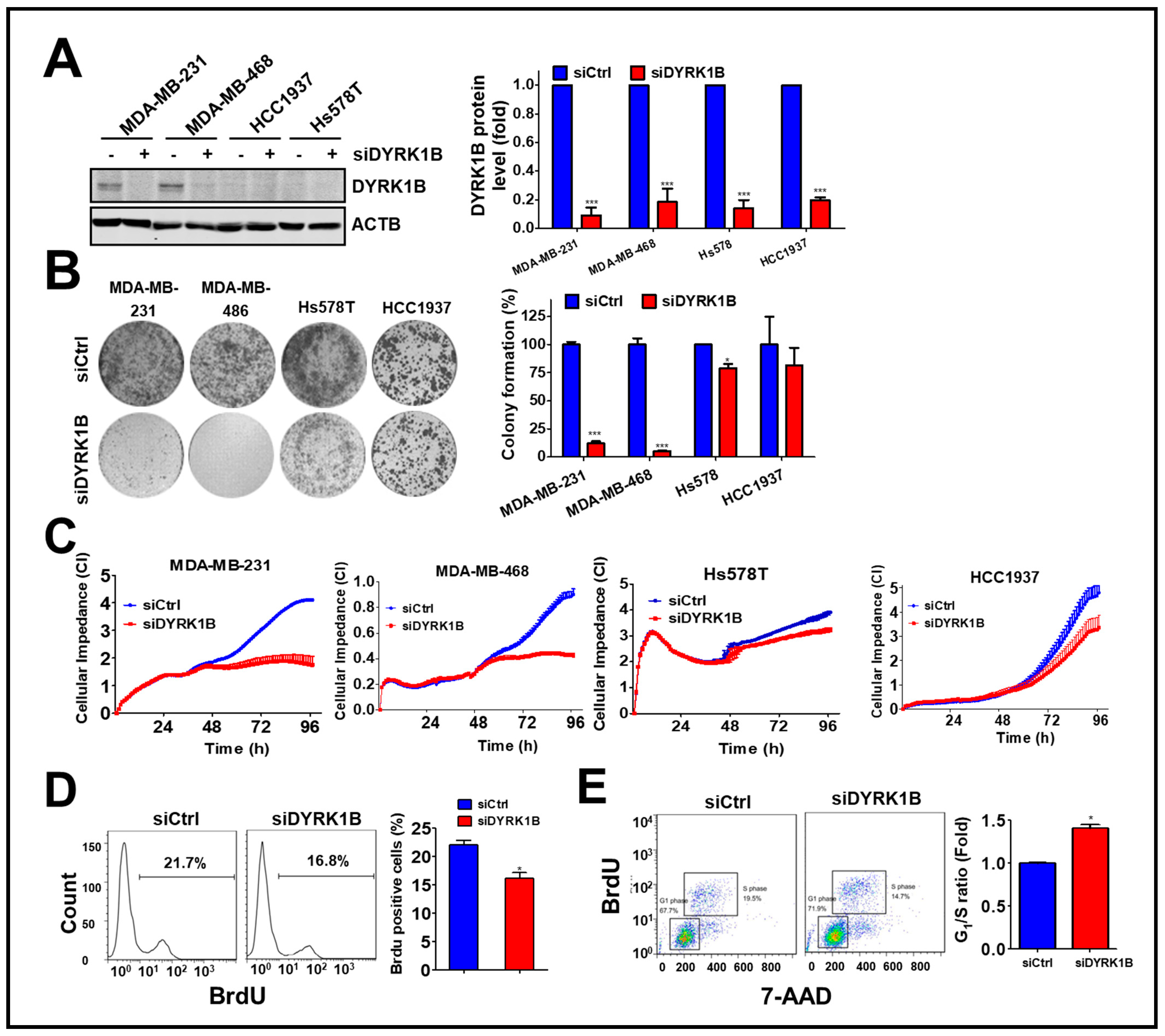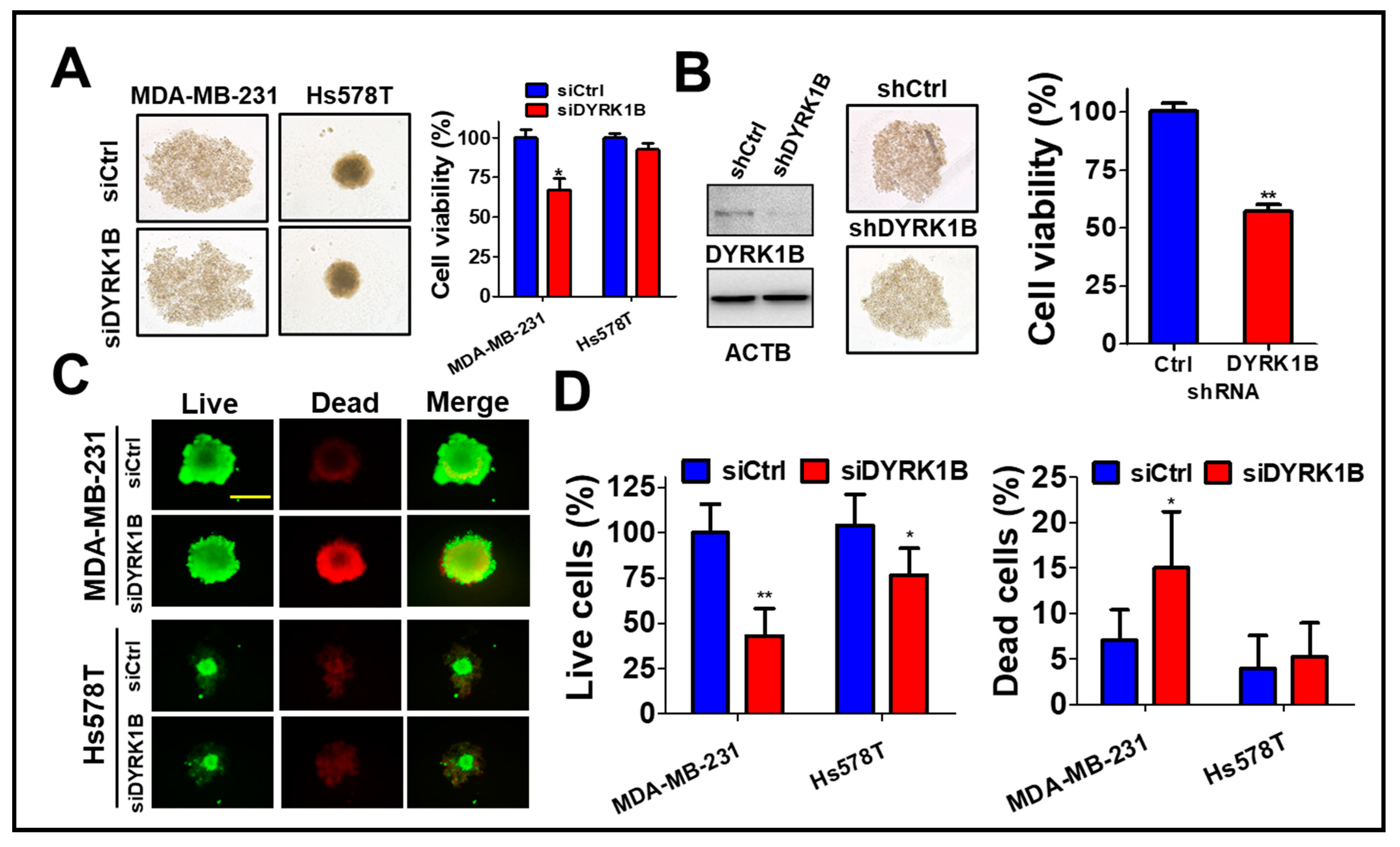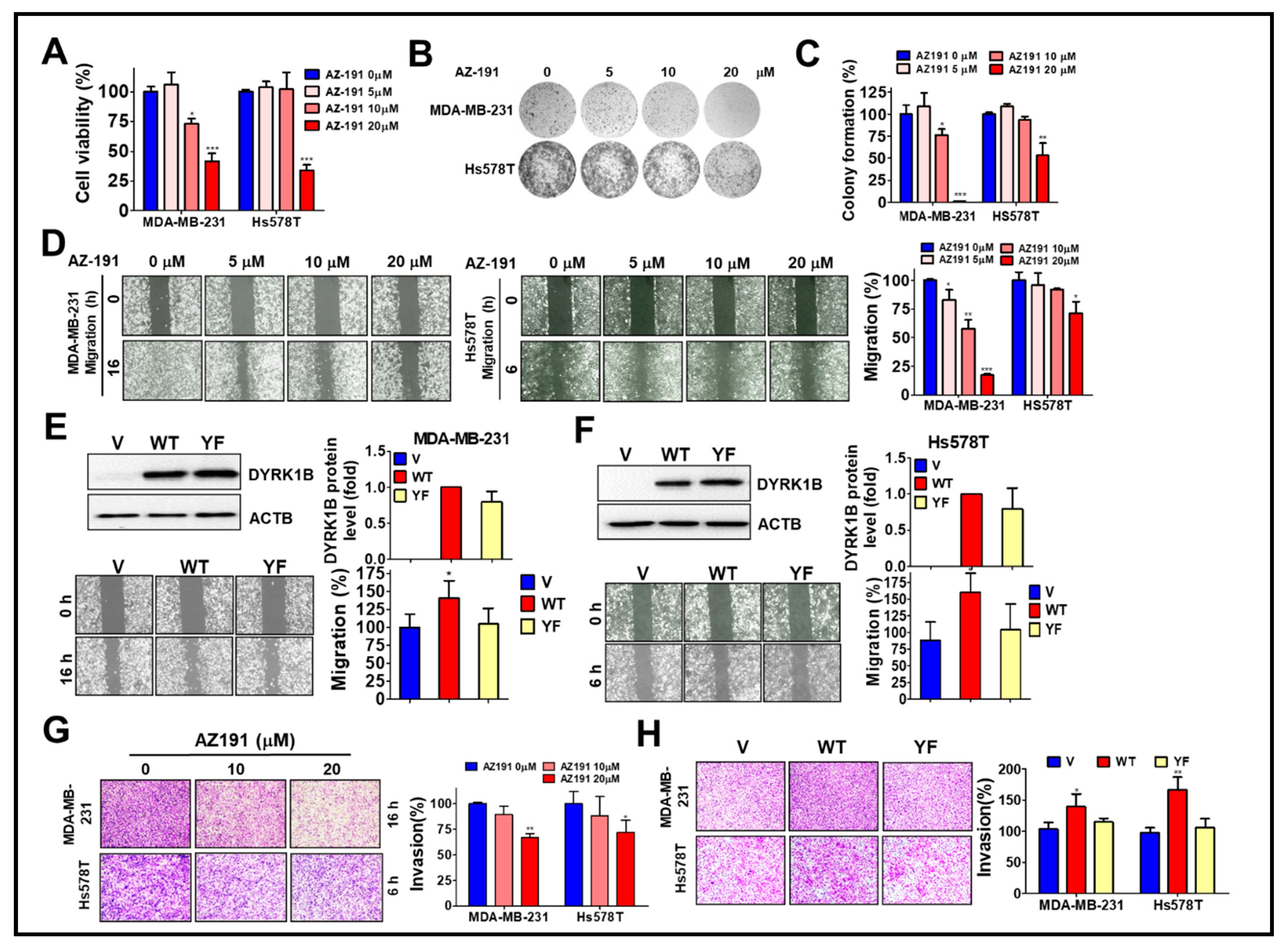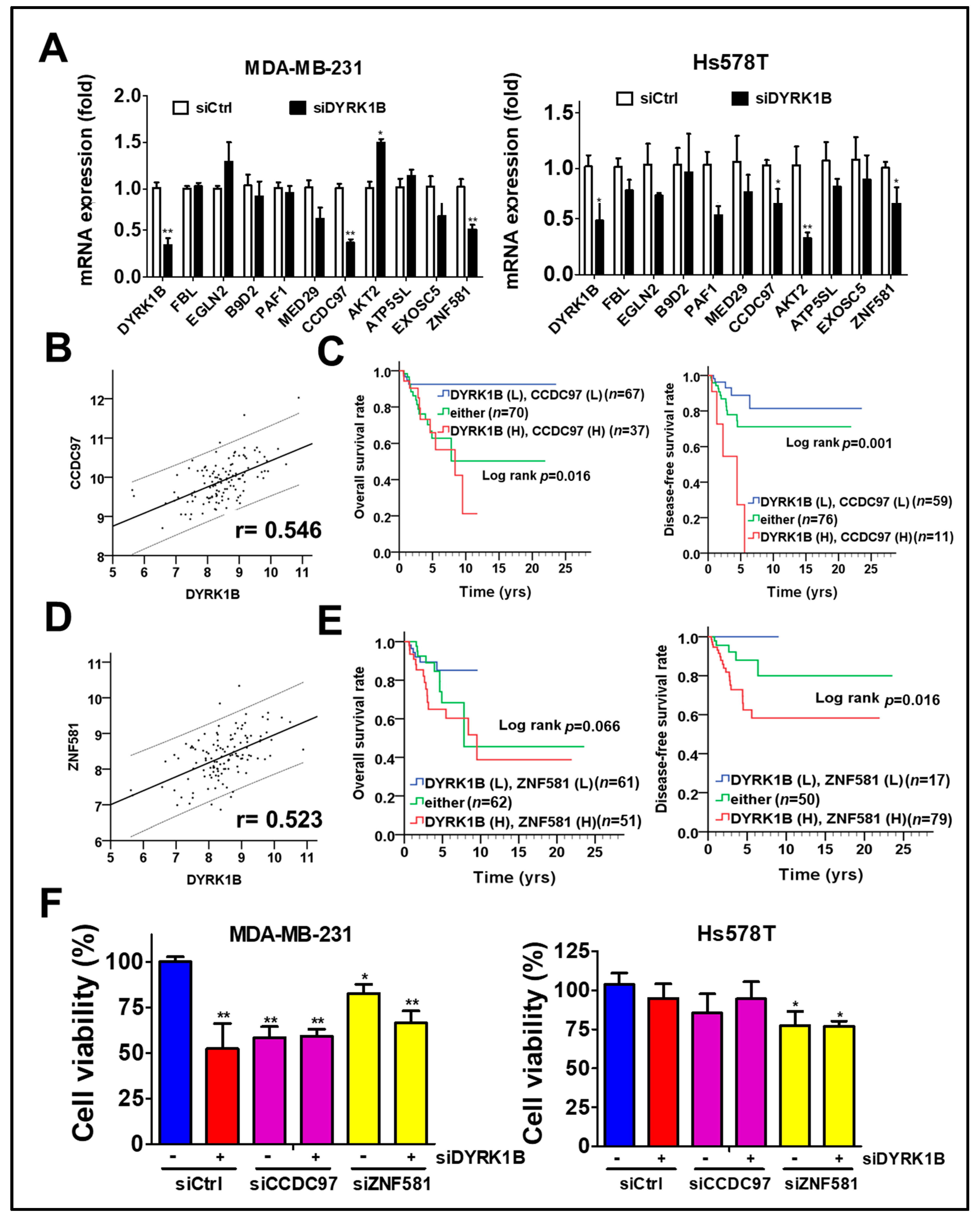Kinome-Wide siRNA Screening Identifies DYRK1B as a Potential Therapeutic Target for Triple-Negative Breast Cancer Cells
Abstract
:Simple Summary
Abstract
1. Introduction
2. Materials and Methods
2.1. Cell Culture and Transfection
2.2. Cell Viability Assays
2.3. Cell Proliferation Assays
2.4. Spheroid Cell Culture
2.5. Cell Mobility Assay
2.6. Real-Time PCR (RT-PCR)
2.7. Western Blot
2.8. Immunohistochemistry and Scoring
2.9. Statistics
3. Results
3.1. Kinome-Wide siRNA Library Screening for the Kinases Required for Proliferation of TNBC Cells
3.2. DYRK1B Confers to Spheroid Cell Formation of TNBC Cells
3.3. DYRK1B Kinase Activity Is Required for Malignancy of TNBC Cells
3.4. The Correlation of DYRK1B Expression with Cancer Development and Survival in TNBC Patients
3.5. Co-Expression of DYRK1B and CCDC97 or ZNF581 Correlates with Prognosis of TNBC Patients
4. Discussion
5. Conclusions
Supplementary Materials
Author Contributions
Funding
Institutional Review Board Statement
Informed Consent Statement
Data Availability Statement
Acknowledgments
Conflicts of Interest
References
- Bianchini, G.; Balko, J.M.; Mayer, I.A.; Sanders, M.E.; Gianni, L. Triple-negative breast cancer: Challenges and opportunities of a heterogeneous disease. Nat. Rev. Clin. Oncol. 2016, 13, 674–690. [Google Scholar] [CrossRef]
- Collignon, J.; Lousberg, L.; Schroeder, H.; Jerusalem, G. Triple-negative breast cancer: Treatment challenges and solutions. Breast Cancer 2016, 8, 93–107. [Google Scholar] [CrossRef] [Green Version]
- Kelly, V.J.; Wu, S.T.; Gottumukkala, V.; Coelho, R.; Palmer, K.; Nair, S.; Erick, T.; Puri, R.; Ilovich, O.; Mukherjee, P. Preclinical evaluation of an (111)In/(225)Ac theranostic targeting transformed MUC1 for triple negative breast cancer. Theranostics 2020, 10, 6946–6958. [Google Scholar] [CrossRef]
- Sanz-Alvarez, M.; Cristobal, I.; Luque, M.; Santos, A.; Zazo, S.; Madoz-Gurpide, J.; Carames, C.; Chiang, C.M.; Garcia-Foncillas, J.; Eroles, P.; et al. Expression of phosphorylated BRD4 is markedly associated with the activation status of the PP2A pathway and shows a strong prognostic value in triple negative breast cancer patients. Cancers 2021, 13, 1246. [Google Scholar] [CrossRef] [PubMed]
- Zhang, J.; Wang, Y.; Wang, J.; Hu, J.; Chen, S.; Jin, J.; Liu, T.; Zhou, J.; Hu, Y.; Ma, D.; et al. Early BCR-ABL1 decline in imatinib-treated patients with chronic myeloid leukemia: Results from a multicenter study of the Chinese CML alliance. Blood Cancer J. 2018, 8, 61. [Google Scholar] [CrossRef]
- Janjigian, Y.Y.; Azzoli, C.G.; Krug, L.M.; Pereira, L.K.; Rizvi, N.A.; Pietanza, M.C.; Kris, M.G.; Ginsberg, M.S.; Pao, W.; Miller, V.A.; et al. Phase I/II trial of cetuximab and erlotinib in patients with lung adenocarcinoma and acquired resistance to erlotinib. Clin. Cancer Res. 2011, 17, 2521–2527. [Google Scholar] [CrossRef] [PubMed] [Green Version]
- Karapetis, C.S.; Khambata-Ford, S.; Jonker, D.J.; O’Callaghan, C.J.; Tu, D.; Tebbutt, N.C.; Simes, R.J.; Chalchal, H.; Shapiro, J.D.; Robitaille, S.; et al. K-ras mutations and benefit from cetuximab in advanced colorectal cancer. N. Engl. J. Med. 2008, 359, 1757–1765. [Google Scholar] [CrossRef] [Green Version]
- Kast, K.; Schoffer, O.; Link, T.; Forberger, A.; Petzold, A.; Niedostatek, A.; Werner, C.; Klug, S.J.; Werner, A.; Gatzweiler, A.; et al. Trastuzumab and survival of patients with metastatic breast cancer. Arch. Gynecol. Obstet. 2017, 296, 303–312. [Google Scholar] [CrossRef]
- Bareche, Y.; Venet, D.; Ignatiadis, M.; Aftimos, P.; Piccart, M.; Rothe, F.; Sotiriou, C. Unravelling triple-negative breast cancer molecular heterogeneity using an integrative multiomic analysis. Ann. Oncol. 2018, 29, 895–902. [Google Scholar] [CrossRef] [PubMed]
- Chandarlapaty, S.; Sawai, A.; Scaltriti, M.; Rodrik-Outmezguine, V.; Grbovic-Huezo, O.; Serra, V.; Majumder, P.K.; Baselga, J.; Rosen, N. AKT inhibition relieves feedback suppression of receptor tyrosine kinase expression and activity. Cancer Cell 2011, 19, 58–71. [Google Scholar] [CrossRef] [PubMed] [Green Version]
- Pascual, J.; Turner, N.C. Targeting the PI3-kinase pathway in triple-negative breast cancer. Ann. Oncol. 2019, 30, 1051–1060. [Google Scholar] [CrossRef] [Green Version]
- Goan, Y.G.; Liu, P.F.; Chang, H.W.; Chen, H.C.; Chen, W.C.; Kuo, S.M.; Lee, C.H.; Shu, C.W. Kinome-wide screening with small interfering RNA identified polo-like Kinase 1 as a key regulator of proliferation in oral cancer cells. Cancers 2019, 11, 1117. [Google Scholar] [CrossRef] [PubMed] [Green Version]
- Williams, S.P.; Barthorpe, A.S.; Lightfoot, H.; Garnett, M.J.; McDermott, U. High-throughput RNAi screen for essential genes and drug synergistic combinations in colorectal cancer. Sci. Data 2017, 4, 170139. [Google Scholar] [CrossRef] [PubMed] [Green Version]
- Cheng, J.S.; Tsai, W.L.; Liu, P.F.; Goan, Y.G.; Lin, C.W.; Tseng, H.H.; Lee, C.H.; Shu, C.W. The MAP3K7-mTOR axis promotes the proliferation and malignancy of hepatocellular carcinoma cells. Front. Oncol. 2019, 9, 474. [Google Scholar] [CrossRef]
- Tzeng, Y.T.; Liu, P.F.; Li, J.Y.; Liu, L.F.; Kuo, S.Y.; Hsieh, C.W.; Lee, C.H.; Wu, C.H.; Hsiao, M.; Chang, H.T.; et al. Kinome-wide siRNA screening identifies Src-enhanced resistance of chemotherapeutic drugs in triple-negative breast cancer cells. Front. Pharmacol. 2018, 9, 1285. [Google Scholar] [CrossRef] [PubMed] [Green Version]
- Chan, S.H.; Huang, W.C.; Chang, J.W.; Chang, K.J.; Kuo, W.H.; Wang, M.Y.; Lin, K.Y.; Uen, Y.H.; Hou, M.F.; Lin, C.M.; et al. MicroRNA-149 targets GIT1 to suppress integrin signaling and breast cancer metastasis. Oncogene 2014, 33, 4496–4507. [Google Scholar] [CrossRef] [PubMed] [Green Version]
- Liu, P.F.; Tsai, K.L.; Hsu, C.J.; Tsai, W.L.; Cheng, J.S.; Chang, H.W.; Shiau, C.W.; Goan, Y.G.; Tseng, H.H.; Wu, C.H.; et al. Drug repurposing screening identifies tioconazole as an ATG4 inhibitor that suppresses autophagy and sensitizes cancer cells to chemotherapy. Theranostics 2018, 8, 830–845. [Google Scholar] [CrossRef]
- Liu, P.F.; Hsu, C.J.; Tsai, W.L.; Cheng, J.S.; Chen, J.J.; Huang, I.F.; Tseng, H.H.; Chang, H.W.; Shu, C.W. Ablation of ATG4B suppressed autophagy and activated AMPK for cell cycle arrest in cancer cells. Cell Physiol. Biochem. 2017, 44, 728–740. [Google Scholar] [CrossRef] [Green Version]
- Shu, C.W.; Bee, Y.S.; Chen, J.L.; Tsen, C.L.; Tsai, W.L.; Sheu, S.J. Detection of autophagy-related gene expression by conjunctival impression cytology in age-related macular degeneration. Diagnostics 2021, 11, 296. [Google Scholar] [CrossRef]
- Shu, C.W.; Weng, J.R.; Chang, H.W.; Liu, P.F.; Chen, J.J.; Peng, C.C.; Huang, J.W.; Lin, W.Y.; Yen, C.Y. Tribulus terrestris fruit extract inhibits autophagic flux to diminish cell proliferation and metastatic characteristics of oral cancer cells. Environ. Toxicol. 2021, 36, 1173–1180. [Google Scholar] [CrossRef]
- Liu, P.F.; Chen, H.C.; Cheng, J.S.; Tsai, W.L.; Lee, H.P.; Wang, S.C.; Peng, W.H.; Lee, C.H.; Ger, L.P.; Shu, C.W. Association of ATG4B and phosphorylated ATG4B proteins with tumorigenesis and prognosis in oral squamous cell carcinoma. Cancers 2019, 11, 1854. [Google Scholar] [CrossRef] [Green Version]
- Liu, P.F.; Chang, H.W.; Cheng, J.S.; Lee, H.P.; Yen, C.Y.; Tsai, W.L.; Cheng, J.T.; Li, Y.J.; Huang, W.C.; Lee, C.H.; et al. Map1lc3b and Sqstm1 modulated autophagy for tumorigenesis and prognosis in certain subsites of oral squamous cell carcinoma. J. Clin. Med. 2018, 7, 478. [Google Scholar] [CrossRef] [Green Version]
- Hammond, M.E.; Hayes, D.F.; Dowsett, M.; Allred, D.C.; Hagerty, K.L.; Badve, S.; Fitzgibbons, P.L.; Francis, G.; Goldstein, N.S.; Hayes, M.; et al. American Society of Clinical Oncology/College of American Pathologists guideline recommendations for immunohistochemical testing of estrogen and progesterone receptors in breast cancer. J. Clin. Oncol. 2010, 28, 2784–2795. [Google Scholar] [CrossRef] [Green Version]
- Wolff, A.C.; Hammond, M.E.; Hicks, D.G.; Dowsett, M.; McShane, L.M.; Allison, K.H.; Allred, D.C.; Bartlett, J.M.; Bilous, M.; Fitzgibbons, P.; et al. Recommendations for human epidermal growth factor receptor 2 testing in breast cancer: American Society of Clinical Oncology/College of American Pathologists clinical practice guideline update. J. Clin. Oncol. 2013, 31, 3997–4013. [Google Scholar] [CrossRef]
- Ashford, A.L.; Oxley, D.; Kettle, J.; Hudson, K.; Guichard, S.; Cook, S.J.; Lochhead, P.A. A novel DYRK1B inhibitor AZ191 demonstrates that DYRK1B acts independently of GSK3beta to phosphorylate cyclin D1 at Thr(286), not Thr(288). Biochem. J. 2014, 457, 43–56. [Google Scholar] [CrossRef] [PubMed]
- Chen, H.; Shen, J.; Choy, E.; Hornicek, F.J.; Shan, A.; Duan, Z. Targeting DYRK1B suppresses the proliferation and migration of liposarcoma cells. Oncotarget 2018, 9, 13154–13166. [Google Scholar] [CrossRef] [PubMed] [Green Version]
- Li, L.; Wei, J.R.; Song, Y.; Fang, S.; Du, Y.; Li, Z.; Zeng, T.T.; Zhu, Y.H.; Li, Y.; Guan, X.Y. TROAP switches DYRK1 activity to drive hepatocellular carcinoma progression. Cell Death Dis. 2021, 12, 125. [Google Scholar] [CrossRef] [PubMed]
- Becker, W. Emerging role of DYRK family protein kinases as regulators of protein stability in cell cycle control. Cell Cycle 2012, 11, 3389–3394. [Google Scholar] [CrossRef] [Green Version]
- Becker, W. A wake-up call to quiescent cancer cells—Potential use of DYRK1B inhibitors in cancer therapy. FEBS J. 2018, 285, 1203–1211. [Google Scholar] [CrossRef] [Green Version]
- Masuda, T.; Itoh, K.; Higashitsuji, H.; Higashitsuji, H.; Nakazawa, N.; Sakurai, T.; Liu, Y.; Tokuchi, H.; Fujita, T.; Zhao, Y.; et al. Cold-inducible RNA-binding protein (Cirp) interacts with Dyrk1b/Mirk and promotes proliferation of immature male germ cells in mice. Proc. Natl. Acad. Sci. USA 2012, 109, 10885–10890. [Google Scholar] [CrossRef] [Green Version]
- Deng, X.; Ewton, D.Z.; Li, S.; Naqvi, A.; Mercer, S.E.; Landas, S.; Friedman, E. The kinase Mirk/Dyrk1B mediates cell survival in pancreatic ductal adenocarcinoma. Cancer Res. 2006, 66, 4149–4158. [Google Scholar] [CrossRef] [PubMed] [Green Version]
- Gao, J.; Zheng, Z.; Rawal, B.; Schell, M.J.; Bepler, G.; Haura, E.B. Mirk/Dyrk1B, a novel therapeutic target, mediates cell survival in non-small cell lung cancer cells. Cancer Biol. Ther. 2009, 8, 1671–1679. [Google Scholar] [CrossRef] [PubMed] [Green Version]
- Hu, J.; Friedman, E. Depleting Mirk kinase increases cisplatin toxicity in ovarian cancer cells. Genes Cancer 2010, 1, 803–811. [Google Scholar] [CrossRef] [PubMed]
- Tang, J.Y.; Ou-Yang, F.; Hou, M.F.; Huang, H.W.; Wang, H.R.; Li, K.T.; Fayyaz, S.; Shu, C.W.; Chang, H.W. Oxidative stress-modulating drugs have preferential anticancer effects—Involving the regulation of apoptosis, DNA damage, endoplasmic reticulum stress, autophagy, metabolism, and migration. Semin. Cancer Biol. 2019, 58, 109–117. [Google Scholar] [CrossRef] [PubMed]
- Gruber, W.; Hutzinger, M.; Elmer, D.P.; Parigger, T.; Sternberg, C.; Cegielkowski, L.; Zaja, M.; Leban, J.; Michel, S.; Hamm, S.; et al. DYRK1B as therapeutic target in Hedgehog/GLI-dependent cancer cells with Smoothened inhibitor resistance. Oncotarget 2016, 7, 7134–7148. [Google Scholar] [CrossRef] [Green Version]
- Skoda, A.M.; Simovic, D.; Karin, V.; Kardum, V.; Vranic, S.; Serman, L. The role of the Hedgehog signaling pathway in cancer: A comprehensive review. Bosn. J. Basic Med. Sci. 2018, 18, 8–20. [Google Scholar] [CrossRef]
- Dai, X.; Cheng, H.; Bai, Z.; Li, J. Breast cancer cell line classification and its relevance with breast tumor subtyping. J. Cancer 2017, 8, 3131–3141. [Google Scholar] [CrossRef] [Green Version]






| Variable | No. (%) | CHR (95% CI) | p Value * | AHR (95% CI) | p Value † | |
|---|---|---|---|---|---|---|
| Overall survival | ||||||
| TNBC | Low | 97 (55.7) | 1 | 1 | ||
| High | 77 (44.3) | 3.42 (1.40–8.39) | 0.007 | 2.45 (0.98–6.11) | 0.055 | |
| ER | Low | 520 (65.4) | 1 | 1 | ||
| High | 275 (34.6) | 0.93 (0.62–1.40) | 0.741 | 0.80 (0.52–1.23) | 0.303 | |
| PR | Low | 444 (64.3) | 1 | 1 | ||
| High | 246 (35.7) | 0.85 (0.55–1.32) | 0.475 | 0.74 (0.47–1.19) | 0.213 | |
| HER2 | Low | 35 (31.5) | 1 | 1 | ||
| High | 76 (68.5) | 1.65 (0.45–6.00) | 0.449 | 2.17 (0.58–8.15) | 0.25 | |
| Disease-free survival | ||||||
| TNBC | Low | 85 (58.2) | 1 | 1 | ||
| High | 61 (41.8) | 3.11 (1.16–8.37) | 0.024 | 2.03 (0.74–5.57) | 0.167 | |
| ER | Low | 322 (48.1) | 1 | 1 | ||
| High | 348 (51.9) | 1.70 (1.01–2.87) | 0.045 | 1.54 (0.91–2.62) | 0.11 | |
| PR | Low | 247 (42.3) | 1 | 1 | ||
| High | 337 (57.7) | 2.18 (1.14–4.17) | 0.019 | 2.10 (1.09–4.04) | 0.027 | |
| HER2 | Low | 61 (70.1) | 1 | 1 | ||
| High | 26 (29.9) | 2.63 (0.53–13.08) | 0.237 | 3.89 (0.65–23.40) | 0.138 |
| Variable | ROC Cutoff | No. (%) | CHR (95% CI) | p Value * | AHR (95% CI) | p Value † |
|---|---|---|---|---|---|---|
| Overall survival | ||||||
| DRYK1B | Low | 77 (44.3) | 1.00 | 1.00 | ||
| High | 97 (55.7) | 3.42 (1.40–8.39) | 0.007 | 2.45 (0.98–6.11) | 0.055 | |
| CCDC97 | Low | 127 (73.0) | 1.00 | 1.00 | ||
| High | 47 (27.0) | 1.65 (0.79–3.43) | 0.179 | 0.97 (0.44–2.12) | 0.935 | |
| DRYK1B (L) CCDC97(L) | 67 (38.5) | 1.00 | 1.00 | |||
| Either | 70 (40.2) | 1.73 (0.84–3.55) | 0.136 | 3.89 (1.30–11.65) | 0.015 | |
| DRYK1B (H) CCDC97(H) | 37 (21.3) | 1.84 (0.86–3.94) | 0.117 | 4.52 (1.42–14.42) | 0.011 | |
| Disease-free survival | ||||||
| DRYK1B | Low | 61 (41.8) | 1.00 | 1.00 | ||
| High | 85 (58.2) | 3.11 (1.16–8.37) | 0.024 | 2.03 (0.74–5.57) | 0.167 | |
| CCDC97 | Low | 133 (91.1) | 1.00 | 1.00 | ||
| High | 13 (8.9) | 3.02 (1.13–8.10) | 0.028 | 1.11 (0.40–3.11) | 0.842 | |
| DRYK1B (L) CCDC97(L) | 59 (40.4) | 1.00 | 1.00 | |||
| Either | 76 (52.1) | 1.26 (0.56–2.81) | 0.574 | 2.11 (0.74–6.01) | 0.161 | |
| DRYK1B (H) CCDC97(H) | 11 (7.5) | 2.05 (0.84–4.98) | 0.114 | 3.26 (1.03–10.36) | 0.045 |
| Variable | ROC | No. (%) | CHR (95% CI) | p Value * | AHR (95% CI) | p Value † |
|---|---|---|---|---|---|---|
| Overall survival | ||||||
| DRYK1B | Low | 77 (44.3) | 1.00 | 1.00 | ||
| High | 97 (55.7) | 3.42 (1.40–8.39) | 0.007 | 2.45 (0.98–6.11) | 0.055 | |
| ZNF581 | Low | 107 (61.5) | 1.00 | 1.00 | ||
| High | 67 (38.5) | 1.41 (0.68–2.92) | 0.351 | 1.28 (0.61–2.68) | 0.513 | |
| DRYK1B (L) ZNF581(L) | 61 (35.1) | 1.00 | 1.00 | |||
| Either | 62 (35.6) | 0.90 (0.41–1.99) | 0.802 | 1.68 (0.60–4.73) | 0.328 | |
| DRYK1B (H) ZNF581(H) | 51 (29.3) | 2.19 (1.06–4.52) | 0.034 | 2.88 (1.11–7.46) | 0.029 | |
| Disease-free survival | ||||||
| DRYK1B | Low | 36 (24.7) | 1.00 | 1.00 | ||
| High | 110 (75.3) | 3.11 (1.16–8.37) | 0.024 | 2.03 (0.74–5.57) | 0.167 | |
| ZNF581 | Low | 23 (15.8) | 1.00 | 1.00 | ||
| High | 123 (84.2) | 26.27 (0.23–3032.62) | 0.177 | 201339.08 (0.00–7.239× 10280) | 0.970 | |
| DRYK1B (L) ZNF581(L) | 17 (11.6) | 1.00 | 1.00 | |||
| Either | 50 (34.2) | 1.13 (0.50–2.56) | 0.768 | 2.27 (0.71–7.27) | 0.167 | |
| DRYK1B (H) ZNF581(H) | 79 (54.1) | 2.02 (0.90–4.55) | 0.090 | 3.36 (1.05–10.72) | 0.041 |
Publisher’s Note: MDPI stays neutral with regard to jurisdictional claims in published maps and institutional affiliations. |
© 2021 by the authors. Licensee MDPI, Basel, Switzerland. This article is an open access article distributed under the terms and conditions of the Creative Commons Attribution (CC BY) license (https://creativecommons.org/licenses/by/4.0/).
Share and Cite
Chang, C.-C.; Chiu, C.-C.; Liu, P.-F.; Wu, C.-H.; Tseng, Y.-C.; Lee, C.-H.; Shu, C.-W. Kinome-Wide siRNA Screening Identifies DYRK1B as a Potential Therapeutic Target for Triple-Negative Breast Cancer Cells. Cancers 2021, 13, 5779. https://doi.org/10.3390/cancers13225779
Chang C-C, Chiu C-C, Liu P-F, Wu C-H, Tseng Y-C, Lee C-H, Shu C-W. Kinome-Wide siRNA Screening Identifies DYRK1B as a Potential Therapeutic Target for Triple-Negative Breast Cancer Cells. Cancers. 2021; 13(22):5779. https://doi.org/10.3390/cancers13225779
Chicago/Turabian StyleChang, Chia-Che, Chien-Chih Chiu, Pei-Feng Liu, Chih-Hsuan Wu, Yen-Chiang Tseng, Cheng-Hsin Lee, and Chih-Wen Shu. 2021. "Kinome-Wide siRNA Screening Identifies DYRK1B as a Potential Therapeutic Target for Triple-Negative Breast Cancer Cells" Cancers 13, no. 22: 5779. https://doi.org/10.3390/cancers13225779
APA StyleChang, C.-C., Chiu, C.-C., Liu, P.-F., Wu, C.-H., Tseng, Y.-C., Lee, C.-H., & Shu, C.-W. (2021). Kinome-Wide siRNA Screening Identifies DYRK1B as a Potential Therapeutic Target for Triple-Negative Breast Cancer Cells. Cancers, 13(22), 5779. https://doi.org/10.3390/cancers13225779






